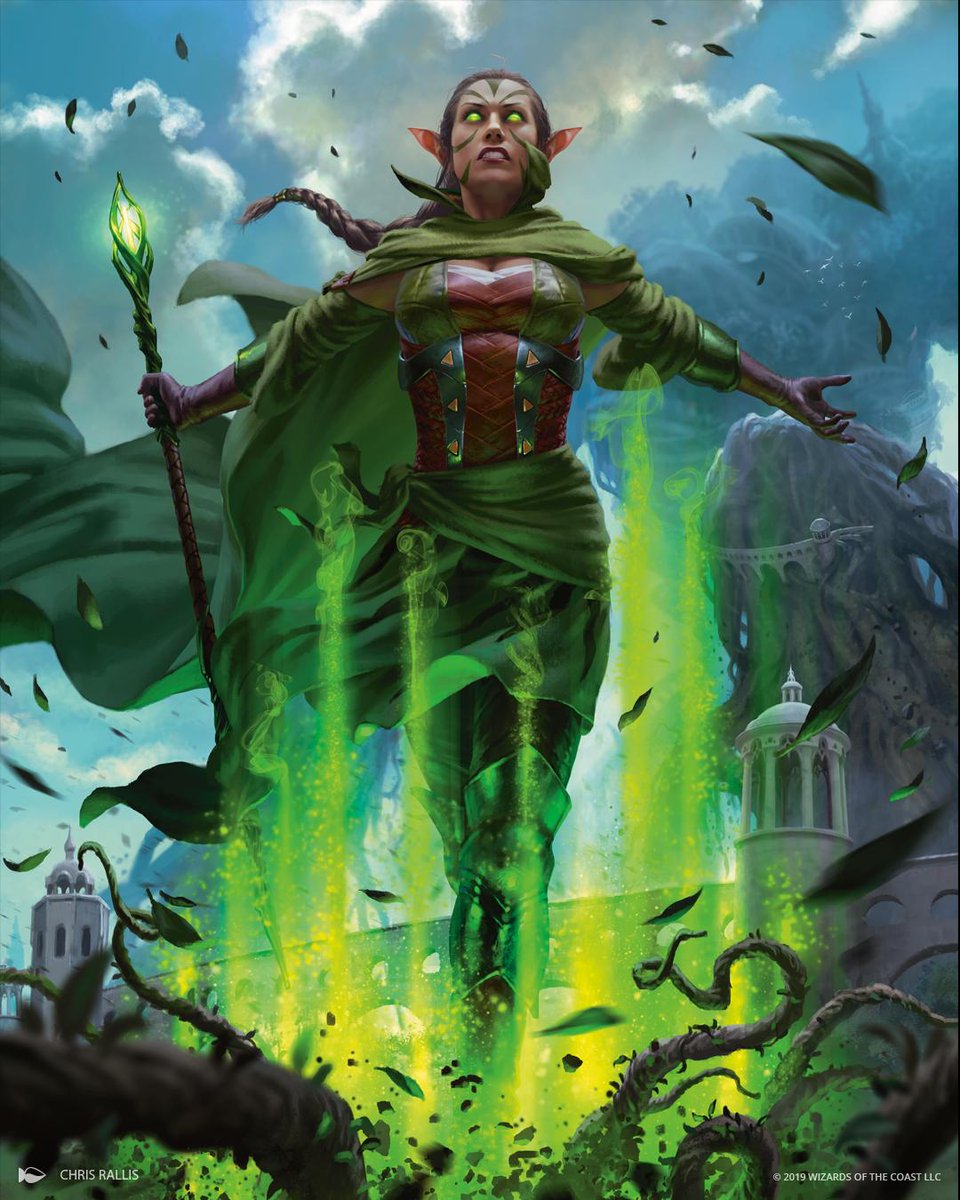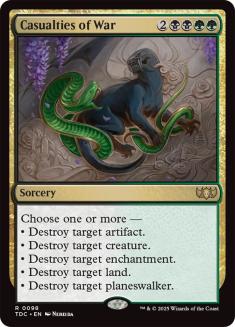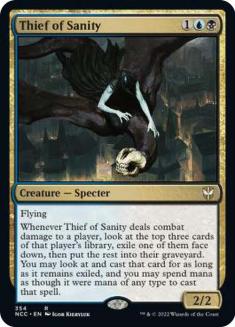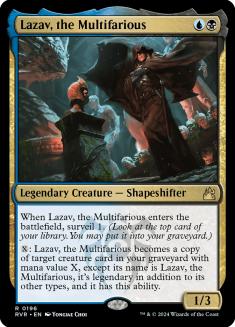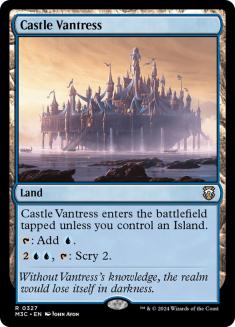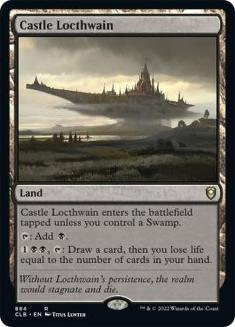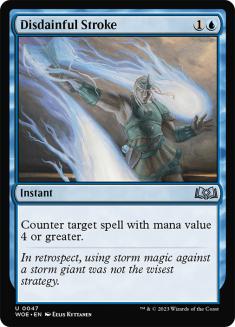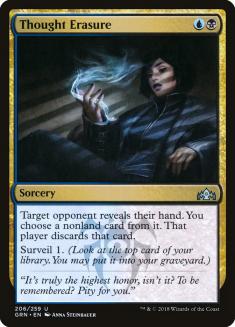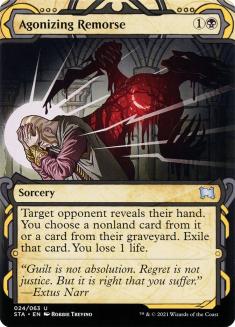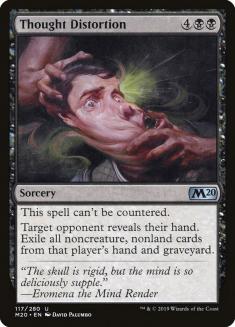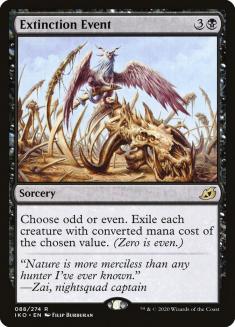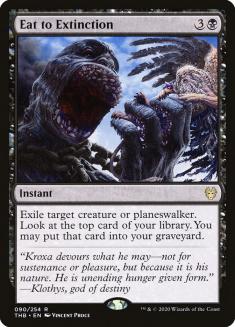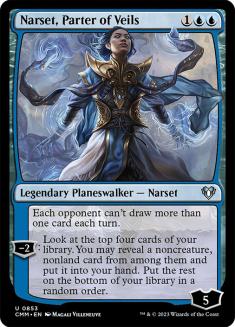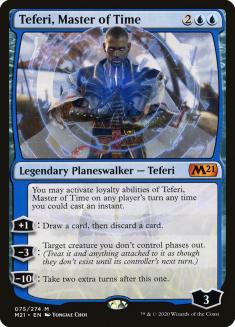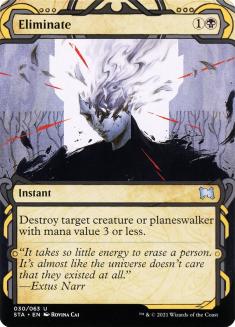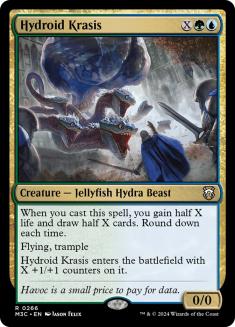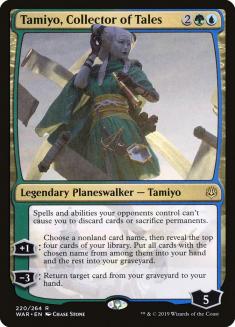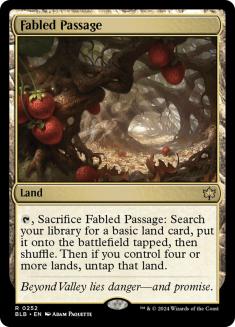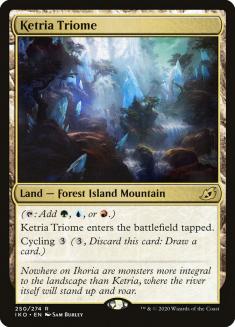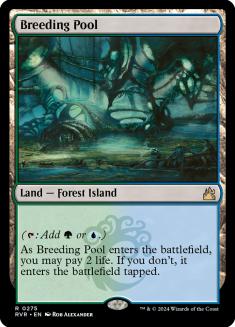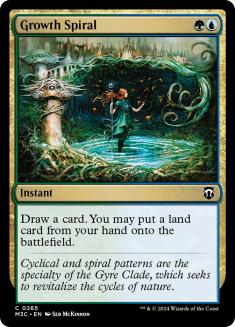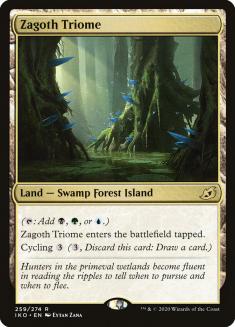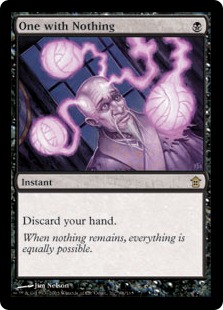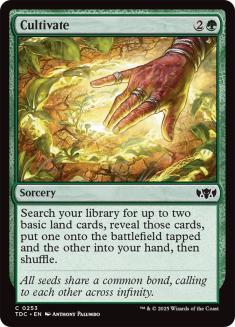If you’re playing Core Set 2021 Standard, you’re probably playing Sultai mirrors. If you haven’t, you probably should be and you should probably read a resource to short cut learning how it works.
Priority 1: Nissa, Who Shakes the World VS Casualties of War
Nissa, Who Shakes the World is one of the most powerful cards in Standard. If it sits on the battlefield, you win the game.
One reason Sultai Ramp is the Nissa midrange deck of choice is because of Casualties of War. There isn’t another clean answer to a resolved Nissa, let alone one that can handle it multiple turns after it resolves. Nabbing the land (often a land and a creature-land) is crucial since it sets them back on the followup and keeps your future planeswalkers unassailable.
The baseline dynamic of the mirror revolves around figuring out how to not die to their Nissa before you can cast Casualties, or how to deploy yours before they can.
Rule one is they can’t always have Casualties. If you cast Nissa and they don’t do the thing, you won. If they do Casualties the still game continues. There’s some risk, but the reward is super high. You shouldn’t default to playing scared because the worst case scenario isn’t always that scary.
You might notice the threat here costs five and the answer costs six. A fairly common play pattern is sticking Nissa, knowing they can’t Casualties, and using the following turn of bonus mana to do a bunch of stuff and bury them harder than just a Casualties can recover. Being on the play is exceedingly strong as a result of this.
Priority 1, Part 2: Don’t Lose to Casualties of War
Controlling a creature is a liability. You can’t control a creature and a planeswalker at the same time due to Casualties of War, and none of the creatures really fight the Nissa battle.
Plus, have you ever hit an Uro, Titan of Nature’s with Thief of Sanity? Not great.
The same Casualties of War stuff applies to artifacts and enchantments. No Mazemind Tomes either.
I only justify Lazav, the Multifarious in my current list because it would otherwise be a third Eliminate in Game 1 which doesn’t help much either, and I promptly sideboard it out.
Casualties also makes the Throne of Eldraine Castles less clutch. They can provide an advantage, but too often you’re forced to take an action then lose your Castle to Casualties. The risk to your untapped mana for early Thought Erasure + Uro curves or when you just need Turn 2 Eliminate against aggro is high enough that shying away from Castles is a good idea.
Priority 2: Discard and Counters
Your blowout spells are five- and six-mana sorcery speed things. You want to spend two mana to answer them. Easy. The two-mana aspect is key for letting Nissa untap a Breeding Pool to defend with Negate against their big plays.
Counterspell density also mitigates the role of Casualties of War after sideboarding. Your Game 1 copies make a big difference, but more out of the sideboard can be exploited and you just want the couple you started with to threaten recovery plays.
But the discard spells might even be better than the counters. Not only can you Thought Erasure a Nissa before it lands, but you can use the discard to take a proactive role and take their counter or removal for your Nissa and run away with the game.
You should bias towards Thought Erasure as rushing to your own Uro and hitting the right draws will always be great, but a few Agonizing Remorse helps mitigate their Uro hands and occasionally can be cast off a Nissa’ed Overgrown Tomb.
Branching Plan: Oops All Counters
Creatures (11)
Planeswalkers (4)
Lands (27)
Spells (18)
- 2 Negate
- 1 Disdainful Stroke
- 4 Thought Erasure
- 4 Aether Gust
- 2 Mystical Dispute
- 2 Eat to Extinction
- 3 Shark Typhoon
Sideboard

If you want to overload on counters, you can also play Shark Typhoon to pressure any planeswalkers that sneaks through. The problem with going hard on the reactive plan is you lose ground against aggro, but the other problem is that the “normal” mirrors can just hang out and cast Thought Distortion. You can’t even punish it on the way back with an Uro because it clears your graveyard as well.
Shark Typhoon is specifically good when you’re overloaded on counterspells or your opponent is. It’s a Level 2 solution to the metagame; don’t play it if things wrap back around to winning on Level 0.
Of course, even if they have all these counters you still have to jam with Nissa into them when you get a chance. Often games come down to you having multiple threats and having to push through the counters, or seeing two unknown cards and hoping one isn’t a counter. Sometimes things line up to give you good continuations into a Negate-backed Nissa, but just as often you are trying to push through Aether Gusts with draw steps.
Creatures (5)
Planeswalkers (3)
Lands (26)
Spells (26)

Be aware that if your opponent has only Uro as a way to mount an offense, you want to be loaded up on cards that exile it over more efficient removal. I messed up in sideboarding against Michael Bonde and am fairly sure normal mirror cards like Aether Gust should have been Extinction Events to force him to find more Uros.
Other mirror breakers that can lose priority depending on their build are Casualties of War and Disdainful Stroke. Resolving Casualties through a million counters is too hard, because even if they have Nissa their game plan plays a better waiting game and they can just set it up with a counter. Disdainful Stroke literally counters no cards in the weird Bonde list, though I didn’t mind a Casualties there to address Castles.
Priority 3: Narset, Parter of Veils
If no one resolves a Nissa, the next layer down is a traditional midrange battle. Card advantage engines are crucial, and Narset, Parter of Veils shuts down most of those and is card advantage itself.
The problem with Narset is that it dies to a Nissa land, that it gets cleaned up by Casualties of War if you extend a creature with it, and that it’s a convenient Eliminate target. But if you land it on Turn 3 it often finds the thing you need to beat Nissa on top of shutting down most of Uro and finding you more value.
Narset also constricts the cards you can afford to play in your deck. You just can’t put Teferi, Master of Time in your deck these days because it can’t +1 against Narset. It also loses to all the same things Narset does in all the same ways. If you were wondering where all the Tamiyo, Collector of Tales came from, this is it.
Also, Teferi just isn’t as good as you think it is. A planeswalker that largely wins the game unopposed but doesn’t generate cards or protect itself in a permanent way is always dicey.
Narset also defines some of the other good interaction in sideboarded games. Eliminate is sometimes a fine card. It’s always putting you down a card to cast, but if they have Narset and another good target like a Shark token or Brazen Borrower I tend to leave one in.
Similarly, as Narset pushes the curves lower and lower Mystical Dispute becomes a reasonable card. It has similar diminishing returns to Eliminate since games can stretch beyond it and it isn’t a two-mana answer versus Nissa, but a couple copies are totally fine.
Priority 4: Uro, Krasis, and Planeswalkers
Finally, if no one dies to Nissa or gets card draw locked out by Narset, the big value threats take over. Big Mulldrifters and planeswalkers are good in midrange mirrors? Shocking!
Uro is critical in the matchup, even if it’s outclassed by Nissa and suppressed by Narset. Getting a land ahead on Turn 3 drastically changes the early Nissa vs Casualties exchange, and Uro in your graveyard crushes attrition games. Your opponent has to have an answer each time you escape it and ends up down two cards. Having Uro in the mirror doesn’t make a hand by itself, but having Uro makes any otherwise functional hand massively better.
Hydroid Krasis is kinda gated by Uro or Nissa, but it is an utterly dominant followup to your ramp. Unlike the old Sultai Explore days, a 4/4 Mulldrifter for six isn’t close to game ending or even game changing. You need Krasis to hit three, four, or more cards to be sure it closes out games, but when the game stretches late you are just crossing your fingers and hoping they don’t top deck Krasis. Four copies of the card can clog up your early-game, but you want enough that you can top deck it in those long games or have it as that killer followup to your ramp.
I’m off Tamiyo at this point. It does relevant things through Narset, but it never does enough. It’s a liability on the draw due to being primed the turn you want to leave up anti-Nissa defenses and eats an Aether Gust too easily.
My experiences with Ugin, the Spirit Dragon have been pretty sub-par. It can’t land early the way Nissa can, still loses to their Nissa since it doesn’t exile the lands, gets really hampered by Casualties of War both after it gets cast since it can’t lock in a card of value and before it gets cast because your seventh land suddenly matters, and still loses to the same counters and discard everything else does.
More Good Plays
It’s an entire additional article and then some to teach you how to cast discard.
Think about the order you perform actions. Don’t Thought Erasure before cracking Fabled Passage since that shuffles away a surveil. Think about Turn 1 Fabled Passage letting you assure the right mana on time, such as if you need to fetch Island to curve Thought Erasure into Narset.
The ideal scenario for Tamiyo is usually to -3 immediately, but if you are naming something the best options are typically Nissa, Uro, or Krasis. You can also leave a card on top with a Temple or Thought Erasure and fire that off.
If you are on the draw with a Turn 3 Uro after they also Turn 3 Uro’d, but you have a Negate or Aether Gust for Nissa, you’re often better off waiting a turn. You can Turn 4 Uro and leave up two mana after the bonus land as opposed to leaving your shields down with one mana.
You can obviously Nissa untap a Forest dual land to leave up two-mana interaction, but if Nissa won’t be attacked and you have the option of leaving up the creature-land or a non-creature land to support your Negate you shouldn’t let your opponent use Eliminate to clear your untapped mana.
Once you make the first creature-land with Nissa, making more doesn’t expose you to Casualties of War more than you already are. They’re choosing land, creature, planeswalker regardless of whether the land is a 3/3 or not.
An early, small Hydroid Krasis can sometimes be relevant if you’re missing a fifth land for Nissa or if your whole hand is locked behind Narset.
In late-games you’re not obligated to destroy lands with Casualties of War. This is most common when Casualties is clearing Uro, Titan of Nature’s Wrath and the extra card in graveyard puts them closer to the next escape.
You are not obligated to minus Narset. If your opponent is going to pressure it with a Nissa land, or sometimes even a 2/2 or 1/1, you are better off in a spot where you dictate it dying on your next turn and locking them out of second main phase card draw.
Mulligans
If you are used to Temur Reclamation mirrors, you need to completely rewrite your heuristics for the Sultai Ramp mirror.
The change from all counterspells to more discard means the early-games play out wildly different. Players get to punch a hole in their opponent’s early progression, know what is coming, and make proactive plays without clear punishes. The reduction in reactive answers means there are less times where you can wait to punish their Nissa and hold yours, and you may as well just jam because if they don’t have theirs to punish you, congrats you played the first Nissa and won.
The fact that Nissa is answerable on the way back also breaks this up. If you counter their Nissa then jam yours, you are tapped down and potentially exposed to Casualties of War. The Wilderness Reclamation version you were fully untapped and ready to squash their next turn of plays before running away with the game. Being the second player to cast Nissa is good if you counter theirs, but certainly not unbeatable.
There’s also the point I made about not having multiple good early ramp spells, so it’s hard to pull ahead and change who has the mana advantage. Just one less axis the game can revolve around, and more games that fall into discard, cast Nissa, jam follow up being the only accessible plan.
100% not joking, this was an immediately keepable hand in the Temur Reclamation mirror. What are they going to do, tap out and punish you with a Wilderness Reclamation? They would die if they missed. Shark Typhoon? You have more mana for when you eventually draw yours.
In the Sultai Ramp mirror, the equivalent hand is utterly unplayable. Who cares about your seventh land drop if the fight is always happening on Turn 5, and they will discard spell you and just jam away knowing nothing is in place to stop them? There aren’t back-and-forth huge stacks, one count Shark sizing battles, whatever.
When I look at an opening hand for Sultai Ramp, once I pass the “enough lands to function” line, I’m looking for two to three pieces from the following:
- A high tier threat: Nissa, Narset, or Uro (multiples of the same one don’t count)
- Disruption for Nissa: Thought Erasure, Casualties of War, Aether Gust
- Cultivate, but only if I’m on the play with Nissa.
- Tamiyo on the play.
There’s too many weird ways for things to line up early to think too deep into the specifics of these sets of cards, but having a couple means you are showing up with the right tools for the fight. If I have that, it’s good enough to hope things line up right. If I don’t, I probably mulligan.
This hand does something and has a plan to get to Nissa. That’s what you are looking for. Keep, hope you hit lands.
The other reason I keep hands that are in the “does multiple things” range is because mulligans are really heavily punished. Six cards isn’t unwinnable, but you need a lot of things to line up on time in the matchup. Missing a land, missing a color, being put down a card to Thought Erasure, being down a piece of expendable cardboard and therefore getting Uro stuck in graveyard, all these things are risks that can result in a six-card hand coming up just short on a key turn and leading to a cascade failure.
Fortunately removing the cards that don’t do things helps a lot to make sideboarded games play out without the mulligan disparity deciding them, but that doesn’t solve the London Mulligan plus open decklists making that a big player to start off the match.
Sideboarding
I don’t want to present a full sideboard guide since the level of “stock, hedged for aggro” versus “inbred mirror stuff” you want to be on varies a ton and makes sideboard plans super list specific, but here’s the heuristics.
Don’t cut your good cards, except for the case where your opponent is contorting your deck to make Casualties of War bad.
If you started with removal, cut it. Again the exceptions are an Eliminate is OK if they have targets in addition to Narset, and Extinction Event is good if they play the no-win condition Uro list.
Bring in every counterspell you have.
I like Thought Distortion even against the “stock” versions of the deck for the same reason it is good against massive amounts of counterspells, but the numbers differ. I would want one, maybe two on the play and only maybe one on the draw. I always want two copies if my opponent has more than a few counterspells.
If Cultivate is in your deck and you are sideboarding in Thought Distortion, probably leave it in. Otherwise it’s negotiable.
In The Margins
If you have played any other discard-midrange matchup, you probably know this already. Just another continuation of “this isn’t the Temur Reclamation mirror”.
So much of what is happening here is in the margins. You can’t plan on specific lineups each game because either discard removes them without redundancy, or you have overloaded on one aspect of the plan which is exploitable. Sometimes they trade off for all your stuff, sometimes you then draw a relevant spell, and so on.
If you lose to unique, new imbalances like not having Thought Distortion for the counter-heavy mirrors that happens. But if things are even in the realm of equal, sometimes you just lose to a mix of the same stuff you expected because you had to keep a fine hand that died to theirs.
But what’s your best chance? Not playing the mirror?
Good luck with that.

